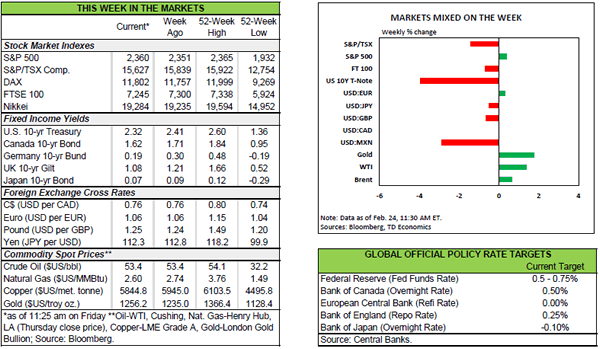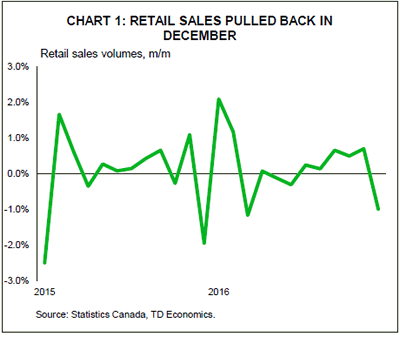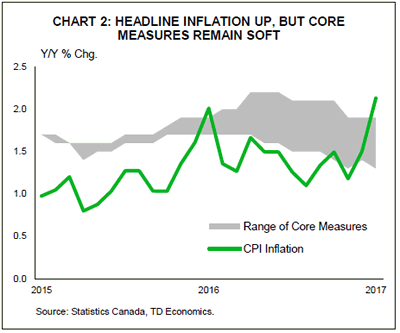HIGHLIGHTS OF THE WEEK
United States
- The outlook for economic growth got a bit rosier this week with the release of the preliminary February survey results of purchasing managers that showed economic momentum continuing to build at the start of 2017.
- The data flow this week was light for the U.S., but existing home sales for January confirmed that the U.S. housing market remains resilient despite the uptick in mortgage rates. Still, the outsized strength in January is unlikely to be maintained, as a number of temporary factors come off in upcoming months.
- Little news in the FOMC minutes other than a confirmation that the U.S. economy was evolving in line with expectations. Overall, the FOMC remains confident that the slow and steady absorption of economic slack, and the corresponding progress of inflation toward its 2% target, warrants a gradual pace of tightening of monetary policy.
Canada
- A soft December retail sales report was a blemish on the otherwise constructive fourth quarter data flow for the Canadian economy.
- We continue to expect the Canadian economy to have grown by 2.2% in 2016Q4, above the Bank of Canada’s expectations of 1.5% advance. Net trade, consumption, government spending, and residential investment are all expected to have contributed to growth.
- For the Bank of Canada, we expect the focus at next week’s decision to remain on the strength of the currency, rising longer-term borrowing costs, and still weak underlying inflationary pressures. As such, we remain of the view that the Bank of Canada is unlikely to move its policy interest rate from 0.50% any time soon.

UNITED STATES – BUILD IT AND THEY WILL COME
This week we got further signs that global economic growth continued to firm at the start of 2017. Despite elevated policy uncertainty, financial market volatility remains low, but it’s unclear if this is a sign of market certainty or complacency about the economic outlook.
Indeed, the global outlook is looking a little rosier than a month ago. Preliminary surveys of manufacturers for February point to continued strong expansion in advanced economies despite elevated political uncertainty from upcoming European elections.
One thing markets have taken notice of is the gains Marine Le Pen has made in the polls. If she were to become President of France, the populist candidate plans to call a referendum on France remaining in the EU if she is unable to renegotiate its terms of membership. The threat of ‘Frexit’ caused spreads between French (and other euro area) bonds with German bunds to widen this week.
The data flow this week was light, but supported our view of U.S. economy growing above its trend pace at the start of 2017. Along with the supportive preliminary manufacturing survey data, January existing home sales rose to the highest level in a decade in January – despite a 70 basis point rise in mortgage rates since last September (Chart 1). Strong existing home sales are further confirmation of the progress the U.S. housing market has made since the crash over a decade ago. Nonetheless, this elevated level of activity is unlikely to be maintained in upcoming months for a number of reasons.
First, some of the activity likely reflects a pulling-forward in contract signings in order to lock-in low mortgage rates. Secondly, unusually warm weather also helped pull forward some activity from the spring market. Lastly, until more sellers put their homes on the market, the low inventory of homes will weigh on sales volumes and put upward pressure on prices (Chart 2). While several years of home price growth have moved helped homeowners to rebuild equity buffers and should allow move-up buyers to re-enter the market, a gradual move higher in housing turnover is more likely than a sudden shift. Overall, we expect the U.S. housing market will record another strong performance this year, supported by fundamentals such as rising household formation and past gains in income and wealth.
The strong performance of the U.S. economy to start the year remains broadly consistent with the Fed’s economic projections, as was noted in the minutes released this week from the first FOMC meeting of the year. The Fed also discussed the uncertainty about the economic impact from the proposed changes in fiscal policy by the new administration, changes that will likely have material implications to the Fed’s economic projections and the pace of policy normalization. Overall, the FOMC remains confident that the slow and steady absorption of economic slack, and the corresponding progress of underlying inflation toward its 2% target, warrants a gradual pace of tightening of monetary policy. Our view is for the next move up the fed funds rate to take place in June, but we cannot rule out a March or May rate hike if the data flow surprises to the upside.


CANADA – 2016 LIKELY TO HAVE ENDED ON A HEALTHY NOTE
The past week saw a grab bag of economic data ahead of next week’s GDP report and the Bank of Canada interest rate decision. The data generally pointed to a healthy economy, as small business confidence rose to a two-year high and corporate profits rose again for a second straight quarter, placing earlier declines firmly in the rear-view mirror.
If there was disappointment to be found in the data, it was in the retail sales figures for December, which saw spending down both in dollar and volume terms (Chart 1). It has been suggested that changing shopping patterns (such as the rise of ‘Black Friday’ sales in Canada) may not be fully accounted for in the data, but in non-seasonally adjusted terms, December saw weaker sales volumes than has been typical of the past five years, consistent with softened consumer demand.
December’s retail sales figures notwithstanding, it appears that Canada had a fairly healthy end to 2016. Quarterly GDP figures, to be released on March 2nd, are likely to show that the economy expanded above its potential speed again in the fourth quarter, with our tracking pointing to an expansion of 2.2% (quarter-on-quarter at annual rates). Net exports are expected to be key driver of growth, alongside consumer demand, real estate, and government investment (further details are included in the ‘Upcoming Releases’ section of this document).
At 2.2%, growth is anticipated to have been stronger than the 1.5% that Bank of Canada was expecting at the time of their January Monetary Policy Report. Somewhat unusually, the Bank will not know the actual growth figure before their monetary policy decision, which is universally expected to be a hold. More interesting than the decision will be the language in the accompanying statement. Governor Poloz likely remains concerned about the level of both the Canadian dollar and longer-term borrowing rates, both of which have been taken along for the ride as their U.S. counterparts have risen post-election.
While higher rates are likely appropriate for the U.S., Canada remains at a different stage of the economic cycle, and we expect Governor Poloz to emphasize this fact once again in an effort to counteract rises in the currency and borrowing costs. Underscoring the challenge that Governor Poloz faces are the January inflation figures (Chart 2). Headline inflation rose sharply to hit 2.1%, but this was largely on the back of energy prices (and, to a lesser extent, associated carbon pricing measures). The Bank of Canada’s three alternative measures of inflation, which attempt to capture the ‘underlying’ dynamics, remained stubbornly soft, reflecting the still sizeable slack remaining in the Canadian economy.
As such, we expect that the Bank of Canada will look through the energy price effects (which are likely to persist for several quarters), focusing instead on these core measures and the remaining slack. While market pricing has moved up in recent weeks on the recent string of solid economic data, we remain of the view that Canadian monetary policy is likely to remain patient. Indeed, given the still sizeable downside risks to the economic outlook, a cut from the Bank of Canada appears the greater risk.















